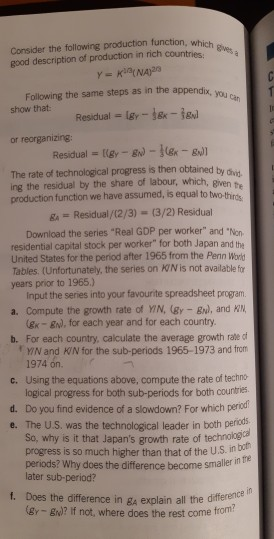Answered step by step
Verified Expert Solution
Question
1 Approved Answer
(7.) GROWTH ACCOUNTING Kim In the appendix to this chapter, it is shown how data on output, capital, and labour can be used to construct


(7.) GROWTH ACCOUNTING Kim In the appendix to this chapter, it is shown how data on output, capital, and labour can be used to construct esti- mates of the rate of growth of technological progress. Consider the following production function, which good description of production in rich countries y = K A25 ppendix. you can Following the same steps as in the appendix, show that: Residual = lgy - 58x - 8 or reorganizing Residual = l(gy - 8) - flex- The rate of technological progress is then obtained by this ing the residual by the share of labour, which given production function we have assumed, is equal to twothie E = Residual/C2/3) = (3/2) Residual Download the series "Real GDP per worker" and "Non residential capital stock per worker" for both Japan and the United States for the period after 1965 from the Penn World Tables (Unfortunately, the series on WON is not available for years prior to 1965.) Input the series into your favourite spreadsheet program a. Compute the growth rate of YN (gy - Bul, and N, x - Bw. for each year and for each country. b. For each country, calculate the average growth rate of YN and ON for the sub-periods 1965-1973 and from 1974 on. c. Using the equations above, compute the rate of techno logical progress for both sub-periods for both countries d. Do you find evidence of a slowdown? For which period e. The U.S. was the technological leader in both pericos So, why is it that Japan's prowth rate of technolog progress is so much higher than that of the U.S. in periods? Why does the difference become smaller later sub-period? f. Does the difference in gA explain all the differe (BY- &? If not, where does the rest come from the difference in (7.) GROWTH ACCOUNTING Kim In the appendix to this chapter, it is shown how data on output, capital, and labour can be used to construct esti- mates of the rate of growth of technological progress. Consider the following production function, which good description of production in rich countries y = K A25 ppendix. you can Following the same steps as in the appendix, show that: Residual = lgy - 58x - 8 or reorganizing Residual = l(gy - 8) - flex- The rate of technological progress is then obtained by this ing the residual by the share of labour, which given production function we have assumed, is equal to twothie E = Residual/C2/3) = (3/2) Residual Download the series "Real GDP per worker" and "Non residential capital stock per worker" for both Japan and the United States for the period after 1965 from the Penn World Tables (Unfortunately, the series on WON is not available for years prior to 1965.) Input the series into your favourite spreadsheet program a. Compute the growth rate of YN (gy - Bul, and N, x - Bw. for each year and for each country. b. For each country, calculate the average growth rate of YN and ON for the sub-periods 1965-1973 and from 1974 on. c. Using the equations above, compute the rate of techno logical progress for both sub-periods for both countries d. Do you find evidence of a slowdown? For which period e. The U.S. was the technological leader in both pericos So, why is it that Japan's prowth rate of technolog progress is so much higher than that of the U.S. in periods? Why does the difference become smaller later sub-period? f. Does the difference in gA explain all the differe (BY- &? If not, where does the rest come from the difference in
Step by Step Solution
There are 3 Steps involved in it
Step: 1

Get Instant Access to Expert-Tailored Solutions
See step-by-step solutions with expert insights and AI powered tools for academic success
Step: 2

Step: 3

Ace Your Homework with AI
Get the answers you need in no time with our AI-driven, step-by-step assistance
Get Started


